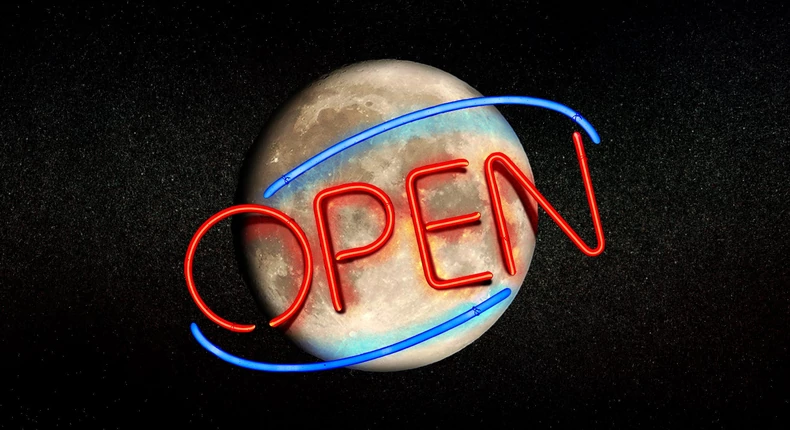The moon is open for business, and entrepreneurs are racing to make billions
If NASA has its way, it will send astronauts back to the moon by the end of the decade, making them the first humans to walk on the lunar surface in over half a century.
- NASA is going back to the moon, and this time it means business.
- Private companies are helping it build lunar transport, GPS, Wi-Fi, and more.
- This new market, which is worth over $100 billion, could be game-changing for humanity.
But this isn’t just another scientific mission. This time around, NASA means business.
With its Artemis missions, the US space agency aims to lay the foundations for the first human settlements beyond Earth and pave the way for extraplanetary colonization. And business is at the core of its strategy.
“It’s not theoretical at this point — it’s happening,” Brendan Rosseau, a teaching fellow at Harvard Business School who focuses on the space economy, told Insider.
The agency is tagging private companies like SpaceX, Blue Origin, Nokia, Lockheed Martin, and General Motors, to develop solutions for its lunar missions such as space-worthy rides, moon streaming, lunar GPS, and more.
This new market — worth over $100 billion— could be game-changing for humanity.
“Definitely the moon is going to be a big business,” said Prachi Kawade, a senior analyst at NSR, a research-and-consulting company focused on the space market.
Artemis is not Apollo 2
What NASA is aiming to achieve on the moon is “something that’s never been done before,” Rosseau said.
While the Apollo missions of the 60s and 70s wanted to see if humans could reach the moon, the Artemis missions want humans to live there, work there, and build there.
At first, lunar missions could be limited to a couple of weeks or months in a lunar base camp. But down the line, the ambition is for the moon to become a hub of human and robotic activity as it develops into a pit stop on the way to Mars.
This creates a lot of opportunities for commercial development along the way, and NASA is aware of that.
“We want to leave behind a wake of commercial activity and commerce and more routine living and working in space,” Steve Creech, acting deputy associate administrator for the Artemis campaign, told Insider.
There could be big bucks in moon mining
Ultimately, the moon’s main commercial draw is its potential for “in-situ resource utilization,” Creech said. This means finding ways to mine and exploit lunar resources on the moon or on Earth.
One commercially-interesting resource is regolith, the scientific name for moon dust. This could be mined for helium-3 — a rare nonradioactive particle that could be used in fusion reactors to create clean energy on Earth — or could also be used for construction on the moon. China, for instance, said it wants to build its lunar station out of regolith.
Another lead for moon mining is the rare-earth elements that millennia of meteorites crashing into the moon may have left behind. These could be mined for electronics, Kawade said.
But the moon’s most attractive resource by far is water. Scientists discovered caches of water near the moon’s poles that could be extracted and turned into fuel to extend lunar missions or to fill up rockets on their way to Mars, per Kawade.
“So the moon becomes a pit stop to Mars,” Kawade said.
We’re probably at least a decade away from sending people or robots to mine the surface of the moon, but that doesn’t mean people aren’t already making money as they lay the groundwork for this business, Kawade said.
“We are talking somewhere about $137 billion in opportunities in the next 10 years, and we estimate about 400-plus missions to be launched during this timeline,” said Kawade.
NASA wants to bring business with it to the moon
Artemis is part of a grander scheme to empower the commercial sector to take charge of space exploration, a move initiated by then-President George W. Bush in the 2000s. He asked NASA to put the private sector at the center of its strategy after retiring the space shuttle program.
Since then, NASA developed a “real commercial-first mindset,” Rousseau said. The agency now awards contracts to private actors to deliver products — such as rockets, landers, or services — against set amounts of money.
This means the agency limits its own research and development costs, while companies can take risks in developing ambitious technology because they have NASA as a built-in customer.
“It is baking in the commercial sector as part of their plans,” said Rosseau.
“It created competition. It created incentives for companies to do things as reliably and also as cheaply as possible,” he said.
Per Rosseau, this model has started to bear fruit. Companies like Blue Origin and SpaceX likely wouldn’t exist without NASA’s ambition to go to the moon, he argued.
There’s money in making future moon settlers comfortable
You can’t have mining on the moon without the proper infrastructure. And those looking to build it are starting to see money coming in.
One way to support long-term missions is to find ways to do cheap Earth-to-moon deliveries. NASA has been investing heavily in the development of uncrewed robotic landers that can deliver goods and services to the moon through its Commercial Lunar Payload Services or CLPS program.
Pittsburg aerospace and robotics company Astrobotic Technology is one of the main players in the CLPS program. It landed a contract worth $320 million to deliver several payloads for NASA.
One such payload, the Volatiles Investigating Polar Exploration Rover or VIPER, is set to be delivered to the south pole in 2024. The robot will seek out traces of water ice on the moon.
Fly me to the moon
However, the most lucrative part of the moon market by far is rocket development, said Kawade, who leads NSR’s lunar-market report.
NASA built its own system for its upcoming Artemis moon missions, the Space Launch System (SLS) mega-rocket with its Orion spacecraft. But the agency has put the development of the mission’s human landing system (HLS), which will bring astronauts from the moon’s orbit to the lunar surface, in the hands of private companies.
Elon Musk’s SpaceX has been the frontrunner in the race to land this bid, gaining billion-dollar contracts to develop the HLS for NASA’s Artemis III and IV missions.
Along the way, Musk has promised to reduce the cost of launch and to make its rockets reusable, which could lower the cost of future missions. NASA’s contracts also boosted the development of the company’s flagship high-capacity mega-rocket Starship, SpaceX’s most ambitious project yet.
There is one drawback: though Starship is crucial for NASA’s upcoming missions, the rocket hasn’t yet successfully flown to orbit. In fact, it exploded on its first integrated launch in April.
Still, NASA isn’t putting all its stock in SpaceX. Blue Origin recently won a $3.4 billion contract for NASA’s Artemis V human lunar launcher, a win for a company that had lost its previous bids to SpaceX. The contract should boost the development of the company’s own mega-rocket, New Glenn.
Even NASA’s SLS spacecraft — which was built and developed in-house, a relic of NASA’s old approach to rocket development — has been big money for the private sector.
Lockheed Martin was awarded a $2.7 billion contract and a $1.9 billion extension to deliver six Orion spacecraft for the Artemis missions III to VIII.
The market may not be self-sustaining before mid-2030, but that may not matter
At this point, NASA remains the most prominent client in the lunar market. If the US government decided tomorrow to pull its backing from private investment, it’s possible the market wouldn’t survive off its own back.
Private investment in extraplanetary exploration and exploitation has only just started to trickle in, which is encouraging, Kawade said. For instance, AstroForge, an asteroid-mining startup in California, has raised $13 million in private capital for two upcoming missions. Lunar Outpost, a space-tech firm from Colorado, raised $12 million in seed investment to develop lunar rovers and technologies.
Still, if the market is to be self-sustaining, companies will need to find other clients to buy what they are selling on the moon, and it’s not clear whether anyone has cracked this business model, Rosseau said. Still, Rosseau anticipates, this flash point could be coming in the mid-2030s.
“I think what really gets investors and businesses excited is seeing these huge tailwinds when it comes to lunar activity,” he said.
Whether the lunar market can survive without NASA might be missing the point anyway, Kawade said. On the way to the moon, companies are likely to discover technologies that can have lucrative applications here on Earth, she said.
Following NASA’s lead, others have also started looping in the private sector to their space exploration programs, including Japan, China, and Russia’s space agencies.
Welcome to the space race of the 2020s
Money isn’t the only drive pushing the US and its allies to bring businesses to the moon. There are strong political incentives to get there before China, Rosseau said.
“It is a fact: We’re in a space race,” NASA’s current administrator Bill Nelson told Politico in January.
“It is true that we better watch out that they don’t get to a place on the moon under the guise of scientific research,” he added. “And it is not beyond the realm of possibility that they say, ‘Keep out, we’re here, this is our territory.'”
More than 24 space-faring nations have signed the US’s Artemis Accords, a set of rules drawn up by NASA for international cooperation on the moon.
China was not one of them. The nation has set its own independent path to the moon, for which it is seeking closer relations with space agencies in Russia, Latin America, and Central Asia.
The US still dominates space. It has more satellites in orbit — 3,433 US satellites in orbit versus 541 for China — and has more budget — about $60 billion in 2021 versus about $16 billion for China, Svetla Ben-Itzhak, an assistant professor at Air University in Pakistan, recently told The Conversation.
Still, China is moving toward the moon on a competitive timeline. It attempted 55 launches in 2021, four more than the US, per Ben-Itzhak. It was also the first nation to put a spacecraft on the far side of the moon in 2019 and has launched its own crewed space station into orbit, just as the International Space Station is nearing the end of its life.
Both the US and China are signatories of the Outer Space Treaty, which means they’ve agreed that no country can militarize or claim the moon. But there is still considerable “first-mover advantage” to whichever business gets there first, said Rousseau said.
Also Read: Eid-el-Kabir: Look out for new moon — Sultan of Sokoto
One issue, for instance, is interoperability between infrastructures. While NASA has been working with collaborators to develop a language that could be used across all lunar devices, China has not been participating. If it gets there first, it could set a different standard, foiling the US allies’ efforts.
“There’s a real incentive for liberal democracies to get there — whoever gets there writes the rules essentially,” Rousseau said.













